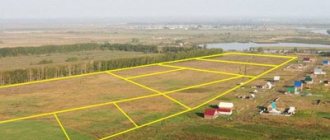What is an assessment of the market value of real estate
Assessment of the market value of real estate is the process of establishing the most probable price of a real estate object at which this object can be alienated on the valuation date on the open market in a competitive environment, when the parties to the transaction act reasonably, having all the necessary information, and the value of the transaction price is not any extraordinary circumstances are reflected, that is, when:
- one of the parties to the transaction is not obliged to alienate the object of valuation, and the other party is not obliged to accept execution;
- the parties to the transaction are well aware of the subject of the transaction and act in their own interests;
- the valuation object is presented on the open market through a public offer, typical for similar valuation objects;
- the price of the transaction represents a reasonable remuneration for the object of evaluation and there was no coercion to complete the transaction in relation to the parties to the transaction on any part;
- payment for the valuation object is expressed in monetary form.
Purpose of market valuation of land
The main goal of conducting a market valuation is to maintain a balance of interests between the seller and the buyer when concluding a transaction for the alienation of a land plot. Also, market valuation is important for accounting purposes.
From the subject composition of this legal relationship it follows that conducting a market valuation is not a prerequisite for completing a transaction. The parties have the right to decide for themselves whether to order an assessment before alienating the land or determine the price themselves at their own peril and risk.
However, the subjects of a potential transaction may not have all the data that affects the price of land:
- They may not know the current state of supply and demand on the land turnover market;
- They may not have information that affects the price characteristics of land;
- They may misjudge the impact of the physical characteristics of a site on its price.
Due to their professional status, appraisers are required to possess all the information necessary to conduct a market assessment of the property, and are also responsible for the unreliability of the report compiled.
Purpose of assessing the market value of real estate
Reasons for ordering appraisal services from professional appraisers may be:
- Determining the value of the object as collateral;
- Purchase and sale transaction with an object;
- Property disputes;
- Putting the object on the balance sheet of the enterprise;
- Contribution of the object to the authorized capital;
- Determination of the market rental rate of the property;
- Revaluation of the book value of assets, incl. real estate objects, enterprises;
- Challenging the cadastral value of a real estate property;
- Property insurance
Self-assessment of land value
Of course, to evaluate a land plot, it is best to contact professional appraisers - this is their job and they are specialists in this matter. But situations often arise when the owner needs to quickly and independently assess the value of his plot. Here we will focus on ways to process price information that our clients use to form their idea of the value of the site being assessed. As a rule, these are offers for the sale of similar plots published on the Internet. From the very beginning, it must be said that the price in the offer for sale is not the market value of this plot, because the price of the purchase and sale transaction and the original price at which the owner wanted to sell the property can differ very significantly. The difference between the offer price and the transaction price is called bargaining, and determining the value of the adjustment for bargaining is one of the stages of any assessment using comparative approach methods.
How much can you bargain with the seller? It all depends on many reasons, but the most important is the predicted market dynamics. If prices on the market are rising, then the seller is unlikely to agree to large discounts; in a growing market, a 5% discount is already a lot. A different situation arises if the market falls, especially if the fall is of a fundamental nature and there are no forecasts for market growth. In this case, as a rule, the following situation arises. Sellers do not sharply reduce prices in offers for sale, since they are not ready to immediately give up a significant part of their income, which they had previously counted on, but when communicating with a real buyer, they are ready to make very significant concessions, since the risk of a deal being disrupted is a very significant factor even when In this outcome, the seller receives nothing, and further exposure of the site on the market in conditions of falling prices will still lead to a decrease in his revenue. Therefore, the difference between offer prices and transaction prices in a falling market can amount to tens of percent (during the acute phase of the crisis in 2009, this value reached 50%), which is why determining this value is such an important point in the valuation of land and undeveloped land plots.
The procedure for assessing the market value of real estate
The process of establishing the market value of a property includes the following sequential stages:
- Concluding an assessment agreement with the Customer;
- Request, receipt and analysis of documents on the assessed object;
- Departure of the Appraiser to inspect the property and become familiar with the property;
- Analysis of the real estate market and the segment of this market to which the property being assessed belongs, analysis of the main pricing factors of the property;
- Carrying out calculations of the value of the valuation object using various approaches and methods using market information on sales of similar objects and the projected profitability of the object;
- Coordination of the obtained result with the Customer, answers to the Customer’s questions;
- Writing a Report on the assessment of the market value of the property;
- Providing the Customer with a completed Assessment Report.
Land assessment
Content:
- How is the market value of a developed plot determined?
- Land valuation cost
- What is the category and type of land plot?
- What affects the value of land?
- What documents will be required?
Conducting a land assessment by a certified appraisal company is a popular and standardized procedure. No matter what period the Russian economy is going through, investors and ordinary citizens continue to be interested in the land market. Moreover, living in country houses is gaining popularity, so land will and remains a liquid and attractive object.
How is the market value of a developed plot determined?
The basis is a comparative approach. Analogues are selected and adjustments are made using market data.
Of course, a real estate object and a land plot are inseparable. However, in order to determine and highlight the value of land, the plot is conditionally accepted for calculation as undeveloped.
Advantages
The shortest possible time for independent assessment
Highest quality independent assessment
Individual approach to assessing each case
Our certificates
Land valuation cost
| Object of assessment | Tariff, rub. | Deadlines |
| Plot | From 3 000 | 2 working days |
| Conclusion | 2 500 | 2 working days |
What is the category and type of land plot?
The current land legislation provides for 7 categories of the following lands:
- agricultural;
- lands of populated areas;
- industrial lands
- lands of specially protected areas and objects;
- forest fund lands;
- water fund lands;
- reserve lands;
In each category there are certain subtypes of expanded use - individual housing construction (individual housing construction, SNT - gardening)
What affects the value of land?
According to analysts, in the land market the cost of land plots depends on the following factors:
- land categories;
- permitted use;
- type of right to land;
- prestige of the destination;
- location and environment;
- size of the land plot;
- availability of communications connected to the land plot
What documents will be required?
| An object | Basic documents | Additional documents |
| House/Cottage/Townhouse | Passport Certificate or purchase agreement | BTI - if available |
| Explication Floor plan Technical certificate | ||
| Land plot | Cadastral passport |
Similar articles:
← House valuation for the bank
Room rating →
Reviews
Olga Anatolyevna June 26, 2021, 17:01 We ordered an assessment of damage from the flood of an apartment in a new building for the court. We quickly collected all the data, prepared a report and assessed the damage. We won the case. Thank you
Consultation on services
The company's managers will be happy to answer your questions, calculate the cost of services and prepare an individual commercial offer.
Cost of work to assess the market value of real estate
The cost of assessing a real estate property depends on the unique characteristics of the property being assessed and the purpose of the assessment itself, such as:
- Valuation for collateral, court, to challenge the cadastral value and other purposes (appraisal reports for various purposes have their own characteristics);
- Type of property: land plots, buildings, structures, non-residential premises, apartments;
- Valuable property rights (ownership/lease rights);
- Location of the object (region of the Russian Federation);
- Object area;
- Functional purpose of the object (single functional purpose or multifunctional object).
The exact cost of the assessment is determined on the basis of the estimated labor intensity of the assessment, determined during negotiations with the Customer.
The approximate cost of the appraisal is presented in the price list, formed on the basis of the typical volume of labor intensity of the appraiser’s work for a particular type of appraisal.
Market value of the plot
The size of the market value depends on a huge number of factors. This parameter is determined for agricultural lands (pastures, hayfields, arable lands, fallow lands), perennial plantings, lands occupied by production, storage or processing facilities, and those on which communications are located, on-farm roads, trees and shrubs intended to protect the site from negative influence of anthropogenic and technogenic factors. To determine the market value of a land plot, it is necessary to know its exact area and fertility. The size of this indicator is directly influenced by:
- Land quality.
- The state of the agricultural market in the region.
- Climatic zone.
- Production volume and product prices.
- Type of land use.
- Type of land and level of productivity.
- Soil topography.
- Remoteness of the land plot from storage, processing or sales facilities.
- The presence or absence of improvements.
- Unemployment level in the region.
- Infrastructure of the region.
- Cost of agricultural machinery and fuels and lubricants.
Comparative approach
The comparative approach involves determining the value of a land plot by comparing the sales prices of similar objects. The approach is based on the principle of substitution - the buyer, acting reasonably, will not pay more for the property than he could pay for a similar plot of land.
The comparative approach shows its effectiveness for estimating the value of undeveloped plots. If there is a sufficient amount of reliable data on the sale of objects for a specific time period, it is possible to obtain the most accurate market value of a site in a specific market.
The comparative approach uses three methods:
- The sales comparison method is considered the simplest and most effective. Based on comparison of prices of similar objects.
- Selection method – used exclusively for built-up objects.
- Distribution method - used to establish the relationship between the value of a land plot and the buildings erected on it.
Cost-effective approach
When calculating the market price of a land plot, the cost approach is practically not applicable. It involves assessing the plot of land with its improvements (buildings, structures, communications). It is assumed that the investor, acting wisely, will not pay a higher price than what it would cost to purchase land for development and erect a similar building on it in a specific time period.
The cost approach is based on the allocation method and determines the market value using the following formula (it is important that the site is used in accordance with the NEI):
Land value = Cost of land with improvements - Cost of improvements.
Formation of the Institute of Land Valuation in Russia
The term “assessment” appeared in the domestic legal system at the beginning of the 19th century. The change from the feudal system to the capitalist one marked the rapid development of the institution of land valuation in connection with the conclusion of transactions (sale, exchange, pledge, mortgage), as well as cases of inheritance and division of noble estates. The new rules required the revaluation of property every 10 years.
In 1859, Instructions were developed for the assessment of state-owned lands for the use of state peasants in the event of their redemption. The procedure involved determining the value and profitability of the plots.
The average yield of leading agricultural crops for each soil category was established. Arable land was divided into 5 classes and 15 degrees. As today, many different nuances were taken into account, including:
- the amount of fertilizer needed;
- average prices of agricultural products;
- imputed net income from its sale.
In the 19th century, the types and forms of land valuation were clearly defined. Guilds of sworn appraisers were created. The abolition of serfdom (1861) posed new tasks: it was necessary to determine the redemption value of peasant landholdings.
In 1861 - 1889, the rules of zemstvo assessment statistics were formed. Methods have been developed and tested to allow for mass assessment of rural and urban land.
Among other things, methods have been developed for determining statistical parameters for comprehensive land assessment, collection and analysis of assessment information. This became a prerequisite for the formation of modern cadastral registration rules
The abolition of serfdom provoked a return from the capitation taxation system to the land taxation system from January 1, 1887. A law on real estate valuation was issued.
From now on, the land administration calculated the cost and profitability of land, and notified the owners about it. On January 18, 1899, a new thematic law was adopted. The assessment of land plots was carried out in two stages:
- detailed description;
- valuation based on the income approach.
There were three independent methods for analyzing the profitability of arable land:
- by the amount of rent;
- according to reasonable revenues and costs;
- mixed method: potential revenue was calculated based on yield and grain prices, costs - based on rental payments.
Remainder method
The main condition for applying the method is the availability of the land plot for development in order to subsequently generate income. An algorithm for determining the value of an object using this method:
- Determination of costs for reproduction/replacement of improvements that correspond to the NEI.
- Calculation of net operating income from a property complex for a specific period of time. Market rental rates are used as a basis.
- Calculation of ground rent in the form of the difference between income from the use of the property complex and income received only from improvements.
- Determining the market value of an object through capitalization of ground rent.
Net operating income (NOI) is calculated using the following formula:
NER = Actual Gross Income – Operating Expenses.
Potential gross income is the income that can be received as a result of renting out the entire area of the property complex when there are no losses from non-payment of rent. Rental rates are assumed to be average market rates for similar properties.
This method is especially relevant for assessing a site built up with commercial properties. It shows its effectiveness in the absence of information on sales of vacant plots.
The remainder method is used under the following conditions:
- existing facilities meet the requirements of the NEI of the land plot;
- the cost of real estate located on a land plot or the costs of its construction, as well as its service life, can be calculated with a high degree of accuracy;
- the annual net operating income resulting from the operation is already known.
The remainder method is used when non-residential real estate is relatively recently put into operation or has not yet been built.







